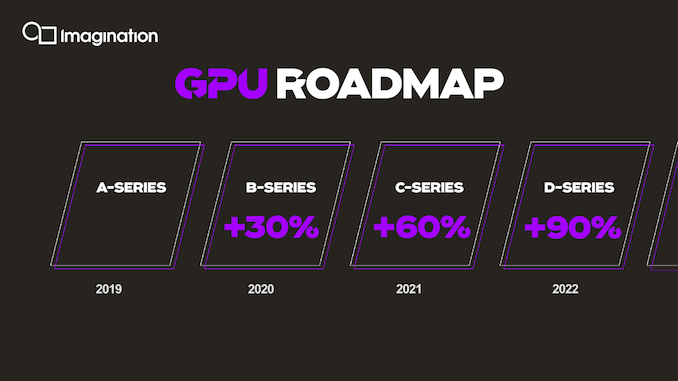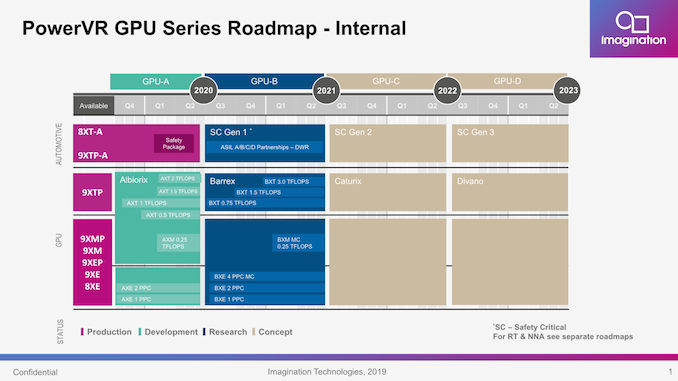Imagination Announces A-Series GPU Architecture: "Most Important Launch in 15 Years"
by Andrei Frumusanu on December 2, 2019 8:00 PM ESTFuture Roadmap & Final Thoughts
The new A-Series architecture means to represent a reset for Imagination’s product offerings, representing a bright new future for the company. The new GPU IP is certainly impressive in terms of the PPA metrics that it promises to achieve, and if realized, it does have ramifications for the wider industry and the competitive landscape.
But even if the A-series can deliver on all of Imagination's promises, the company can't stop there. The competition is continuing to refine and improve their designs, and so must Imagination. To that end, along with today's announcement of the A-series, Imagination is also publishing a very broad roadmap for the next few years, outlining the upcoming GPU generations and their expected performance gains. All of this is especially important for SoC designers, who want to know what's coming down the pipe before making the effort to switch IP vendors.
Imagination’s roadmap following the A-Series is seemingly very aggressive, promising yearly updates going forward, with large annual performance increases of 1.3x, or a 30% yearly compound annual growth rate. This is a much bigger goal than we’re used to historically, but it’s very much in line with the pace of progress we’ve seen from some vendors in the past, or even what Apple has managed to recently achieve over the last two generations.
For the A-Series, Imagination has adopted a public announcement schedule more similar to Arm’s, meaning that the A-Series has already been finished and licensed out to customers, with SoCs being designed and prepared to hit the market for 2020 – we’re assuming the latter part of 2020.
The B-Series is already well under way in terms of development and projected to be completed by next summer if the roadmap is to be taken as an accurate schedule, so at least Imagination has a strong path forward.
What’s important here for Imagination, is managing to actually achieve design wins for the new GPU IP in meaningful higher volume sockets. In terms of possible customers, it’s an increasingly small list, with most of them being the smaller Chinese SoC vendors such as RockChip, Unisoc (formerly Spreadtrum). Samsung is an unlikely client given their plans with AMD as well as custom GPU development, unless there happens to be some opportunity in the low and mid-range segments. HiSilicon likely is tied to Arm, if their plans of a custom GPU don’t pan out. This leaves MediaTek as one of the bigger clients, with the most opportunity and likelihood of adopting the A-Series. Holding onto more MediaTek SoC wins, instead of having them flip-flop between PowerVR and Mali, would be a big win for Imagination and its GPU group. With MediaTek now having re-entered the flagship SoC market, it seems like a very good match.
The wider semiconductor industry is said to be in an architecture revival phase, realizing the need for stronger designs in order to make up for decreasing yearly improvements in process performance. Imagination’s A-Series here seems to be a perfect example of such a revitalization, bringing with it massively impressive generational jumps. If the improvements pan out in practice, I do believe it could be a turning point for the company, and in the future we indeed might look back on it as being the most important launch in the company’s mobile history.












143 Comments
View All Comments
s.yu - Wednesday, December 4, 2019 - link
No, on the contrary it's reason that Cambricon has to let them if they do.Note the recent 251 incident in which the Party went all-out for 3 days censoring everything trying to suppress the incident, but ultimately failed and they pulled back, and now Huawei for once shows its true colors to the people.
ksec - Tuesday, December 3, 2019 - link
As mentioned by the poster below, I think they are likely to be bought rather than doing well.If you look at the High to Mid End Smartphone, they are dominated by Apple, Samsung, Huawei all using their own Silicon or Qualcomm chip. Which leaves the low end with Mediatek.
Now the low end market only cares about cost, so ARM is actually a better choice due to IP bundling listening.
So I am not too optimistic, and it is also worth mentioning. For anyone who was old enough to remember what the Golden Era of GPU, there were always a new design that claims to be better on paper, and what happened?
Drivers - It is the software. The single biggest unmentioned roadblock to GPU computing. How to efficiently use the hardware is the key. S3, Matrox... and lots of others, remember those?
If I reading correctly this design put even more importance to drivers.
adriaaaaan - Tuesday, December 3, 2019 - link
Thats definitely true but the Vulkan API actually takes away a lot of the driver aspect from the equation. Thats the reasons it exists on so many platforms, because it doesn't depend on the os quite so muchmode_13h - Wednesday, December 4, 2019 - link
Huawei uses Mali GPUs, right? So, once they drop ARM CPU cores and go with a Chinese RISC-V core, they're gonna need a different GPU supplier. Hence, Imagination.In fact, had Apple not dropped Imagination, I wonder if Verisilicon wouldn't still be pumping Vivante's IP.
ET - Wednesday, December 4, 2019 - link
Matrox is still around. Not doing anything on the 3D chip front, but still using its own ASICs for 2D, far as I understand. Using AMD for 3D.VIA, who bought S3, are still around, but I don't know if its newer CPUs include custom made GPUs.
> there were always a new design that claims to be better on paper, and what happened?
Most of them were also better in practice. Though most of them had drawback. It was quite an interesting time. APIs were quite a problem then, and the limited amount of stuff one could do in hardware, but it definitely was an era of growth.
mode_13h - Wednesday, December 4, 2019 - link
Well, if you're going to stretch that far, you might as well also cite Intel.Threska - Wednesday, December 4, 2019 - link
PowerVR (NEC) in a console as well as a PC part.vladx - Wednesday, December 4, 2019 - link
You just ignored that MediaTek just re-entered the high-end SoC market. Or most likely, if you didn't even bother reading the article.ph00ny - Monday, December 2, 2019 - link
Everyone keeps saying if they bring it out. How does a fabless GPU designing firm like imagination "bring it out"?shabby - Monday, December 2, 2019 - link
They use their... imagination 😂